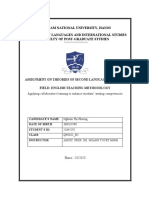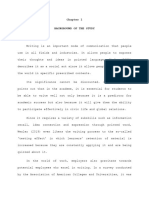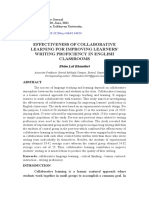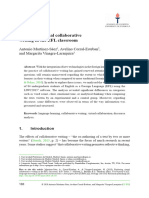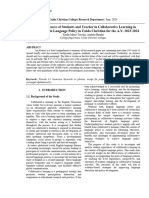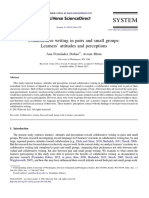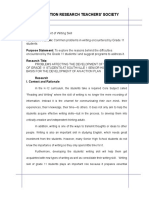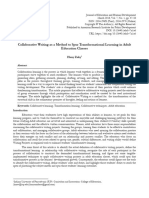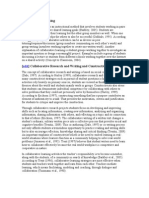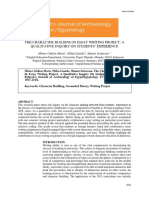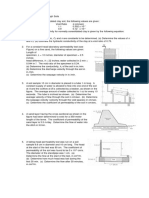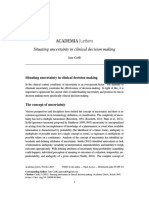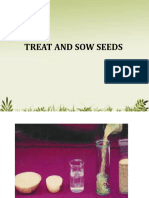Exploring Student Perceived Learning
Uploaded by
dilshodakhonmakhmudovaExploring Student Perceived Learning
Uploaded by
dilshodakhonmakhmudovaExploring Student-Perceived Learning
Gains from a Social Justice Collaborative
Writing Project
Quang C. Ly
University of Miami
ABSTRACT
In this qualitative study, the researcher was interested in understanding the kind of content knowledge students attained
after participating in a social justice writing project. The study, underpinned by the theory of social constructivism, involved
thirty students who worked on a group research paper. Data was collected through an online survey that asked students
to reflect on their writing experience. The results indicated that collaborative writing facilitated peer learning, which was
partly attributed to the active dialogues and group discussions centered around students’ research findings. Students
reported acquiring content knowledge about the historical backdrop of their social justice issue, the key individuals
involved, and prevalent terms commonly linked to the issue, among other aspects. In terms of writing-related knowledge,
students indicated that they learned various skills, including synthesizing sources, creating an annotated bibliography,
and citing in MLA/APA formats, among other things. The study suggests that writing instructors should design
projects that foster collaboration because this collaborative approach not only enhances students’ understanding of course
content but also contributes to developing their writing skills.
Keywords: collaboration, collaborative writing, peer-to-peer learning, social justice
Introduction two or more team members to produce a
Writing is a social act that can be single text (Allen et al., 1987; Ede &
externalized through public conversation Lunsford, 1985). Writing is rarely an
(Henschen & Sidlow, 1990). When students individual endeavor (Aydin & Yildiz, 2014, as
embark on a writing task, individually or as a cited in Vygotsky, 1978). It is likely that
group, the composition process generally students will participate in group writing
encompasses the assistance of others who activities during their college years, and this
contribute to creating and completing the collaborative approach to writing will likely
final product. Taking that understanding persist beyond their academic life. Therefore,
further, the process of collaborative writing, colleges should not only prepare students for
in essence, involves the combined efforts of their prospective careers but also provide
Journal of College Literacy and Learning • Vol. 49 • 2024
7
them with the skills for effective participation often seek from their more skilled peers. This
in group writing tasks. This preparation is assistance pertains to the language skills they
crucial as it mirrors the collaborative work need reinforcement in and the type of
environment they will encounter in their language competencies they can cultivate
future careers. We should, then, equip through peer learning (Blin & Appel, 2011;
students with the skills to confidently engage Dobao, 2014; Du, 2018). Feuer (2011), for
in collaborative writing, foresee potential example, studied the impact of a collaborative
collaboration hurdles, adeptly manage internal writing project on second-language students’
disagreements, and master effective strategies proficiency development. The study involved
for accomplishing collaborative tasks. In six third-year Hebrew students from the
school, when students work on essays on their University of Maryland, who were tasked with
own, each student would receive an individual creating a fictional town for their stories (pp.
grade. However, in a professional 128–129). The findings revealed that students
environment, projects are often undertaken by made substantial progress toward gaining a
teams to achieve a broader, shared objective higher level of proficiency due to continued
(Bush & Zuidema, 2013). exposure to hearing new vocabulary and
Given the paramount importance of grammar being repeated in conversation and
mastering collaborative writing in professional seeing it appear in others’ writing pieces. As a
settings, it is essential to persistently delve result of the exposure, students started
deeper into this field of study (Supiani, 2017; applying their newly acquired knowledge in
Wang et al., 2017). The research objectives their assignments and verbal communication.
aim to investigate the specific content The continuous interaction with peers who
knowledge that students can acquire through possess proficiency in a language is an
participation in a collaborative writing project, advantage derived from collaborative
as well as the sources of this knowledge. discussions and peer-editing sessions (p. 136).
These objectives are important because they Aside from language skills, developing
can provide writing instructors and instructors writing skills is another significant learning
across the university with new insights and benefit of collaboration. In 2013, a study by
methods for creating practical group Luna and Ortiz aimed to discover the
assignments. Furthermore, it can amplify the implications of collaborative writing on
advantages for students and enrich our academic writing at the tertiary level (p. 133).
comprehension of how collaboration can After examining the written papers and video
bolster students’ writing abilities and grasp of recordings, the researchers concluded that
the course content. EFL students “were more aware of the
importance of capitalization, the use of
Literature Review connectors, transition words, and punctuation
than before the intervention” (pp. 134–138).
Benefits of Collaborative Writing The benefits that can be acquired or realized
There is extensive literature on the through writing collaboratively extend beyond
advantages of collaboration in an educational the classroom and into the workplace,
environment, mainly dealing with English as a something that Ede and Lunsford (1985)
Foreign Language/English as a Second noted in their study: “Arriving at a consensus;
Language (EFL/ESL) students (Ahmad, 2020; looking at an issue from several differing
Feuer, 2011; Kessler et al., 2012; McDonough viewpoints; learning to listen carefully and to
et al., 2018). In the context of group respect the views of others; inferring sound
assignments, studies within the EFL/ESL conclusions from particular instances” (pp.
field have underscored the specific support 124–125).
that students with less linguistic proficiency On top of second-language students
Journal of College Literacy and Learning • Vol. 49 • 2024
8
learning how to speak and write in the English into parts: “[S]uccessful collaboration cannot
language, working with their peers can also be reduced to the visible participation of
provide a forum for students to understand students in the collective activity, nor to the
common writing concepts. Blin and Appel’s apparent division of labor. As the activity
(2011) study confirmed that collaborative unfolds, the mediational and collaborative
teamwork, along with Web 2.0 applications structures of the activity are likely to transform
(such as computer-mediated technologies), themselves in unexpected ways” (Blin &
has helped second-language students Appel, 2011, p. 478). This unexpected way
understand more about the writing process, could mean a shift from working collectively to
audience awareness, and the need to focus on working individually, necessitating dividing a
form (pp. 473–475). Collaboration, then, sets group writing project into separate parts to
the stage for enhancing individual cognitive accommodate various factors impacting the
growth. If students are deficient in a particular students involved (e.g., specific assignment
skill, group interactions provide an parameters, language needs, team goals,
opportunity for them to acquire or develop it. competing commitments). This fluid process
Trentin (2009), for example, learned that co- highlights the dynamic and complex nature of
writing offers opportunities to develop collaborative writing.
reading, writing, reflection, and critical Furthermore, in the context of a
thinking skills. collaborative project, it is not uncommon or
Collaborative writing is gaining unexpected for the contributions of individual
prominence in academic circles (Supiani, students to vary, with some contributing more
2017) and in professional settings (Wang et than others. This disparity in contribution
al., 2017). As a result, more and more levels is a natural aspect of group dynamics
domestic students are participating in (Kessler et al., 2012). A typical way to divide
collaborative writing exercises. These activities the workload is to assign or have students
help them develop critical skills, such as the volunteer for specific project parts, reflecting
ability to synthesize arguments (Granado- the copy-and-paste strategy. Students
Peinado et al., 2023) and to write expository essentially focus on their respective tasks
texts (Li & Mak, 2022). before subsequently merging their
contributions into the primary document. This
Equitable Division of Labor Issue approach is referenced by Allen et al. (1987)
At the same time that collaborative writing and observed in a multimodal collaborative
promotes learning benefits (Li & Zhu, 2017; project by Allagui (2023). However, when
Trentin, 2009), a drawback to writing teams choose to divide tasks and work on them
collaboratively is the equitable division of labor separately, this approach can lead to the final
issue. Some teachers and students believe piece of writing appearing fragmented and
group members do not always share work lacking in coherence: “the final group essay
equally (Blin & Appel, 2011). As such, students lacks structure and cohesion; individual essays
typically express anxiety about collaborative follow each other, and are introduced by a
projects because of the uneven workload single sentence; both the introduction and the
distribution (Allagui, 2023). Given this conclusion are short and remain rather
phenomenon, teachers must wrestle with an general” (Blin & Appel, 2011, p. 490). Despite
equitable way of providing a fair grade for the efficiency of task division, the risk of
students in group projects (Daemmrich, 2010). producing a disjointed and incoherent final
Despite students’ efforts to employ a divide- output remains a significant concern.
and-conquer strategy for efficiency,
collaboration can arguably be viewed as a Reluctance Toward Collaboration and
holistic process, which cannot be subdivided Collaborative Assignments
Journal of College Literacy and Learning • Vol. 49 • 2024
9
Beyond the challenges of ensuring an to know who is responsible for what part of a
equitable division of labor, additional factors shared document because there could be
contribute to the resistance toward consequences for using incorrect statements of
collaborative writing. Chisholm (1990) fact or law, such as those typically seen in the
identified four problems associated with legal field, making some professionals wary of
collaborative writing. In collaborative writing, writing with others (Wang et al., 2017, pp. 10–
some students resist participating in group 11). Other times, students believe that working
work because of scheduling conflicts, different together on a writing project is stressful
priorities, or lack of interest (pp. 92–96). Some because there can be a lack of communication
students also lack experience working or effort from the team (Allagui, 2023).
productively in a collaborative setting and are
not trained to provide constructive feedback Building Success Together Via
on team members’ contributions (pp. 96–101). Collaboration
Another problem that is typical of working While some students and teachers may
collaboratively is the interpersonal conflicts or express reservations, the potential for greater
friction that arise from the different content comprehension significantly
personalities and opinions of the members (pp. outweighs the critiques associated with
102–104), a problem also identified by Bush collaborative writing. The distinct advantage
and Zuidema (2013) and Daemmirch (2010). lies in merging various students’ unique writing
Lastly, an additional challenge arises when knowledge, skills, and abilities. This process,
there is an uneven distribution of effort in a known as ‘collective scaffolding’ (Villarreal &
group project, with some students participating Gil-Sarratea, 2019), facilitates the attainment of
more than others (which has also been a common goal. Deveci (2018) found that the
observed by Kessler et al.). This imbalance “variety in skills such as reading, organization,
raises questions about the equity of grading and computer allowed students to produce
(pp. 104–106), a problem also identified by better quality work and learn from each other”
Daemmrich (2010). (p. 727). Blin and Appel (2011) found that
In addition to the challenges highlighted by when students merged their parts into the main
Chisholm, collaborative writing presents other Google document, “language errors and
complexities. Among these is the question of oddities became shared problems, which
authorship (e.g., the decision on who should be students tried to solve collectively” (p. 494).
listed as an author can be influenced by the This finding is echoed in Deveci’s (2018) study,
extent of their contributions), a topic also which learned that editing (i.e., peer feedback)
discussed by Dobao (2014) and Lunsford and was the most frequently cited benefit, with
Ede (1986). It is essential to understand that students who believed that “team members fill
writing is fundamentally a collaborative and each other’s gaps in writing” (p. 727).
social endeavor. Therefore, students need to Other commonly cited benefits of working
appreciate that writing, especially beyond the together include the generation of ideas (e.g., it
academic sphere, necessitates active fostered creativity among students) and time
engagement in communication with others management (e.g., workload division enabled
(Wardle & Downs, 2023, p. 17). However, it is students to accomplish more work in less time)
worth noting that some individuals perceive (Deveci, 2018, p. 727). These kinds of benefits
writing as a solitary endeavor, as expressed by extend to multimodal collaborative writing
one interviewee from Wang et al.’s (2017) projects as well. In such settings, students have
study: “You’re watching other people writing reported that their positive attitudes toward
and you know yourself to be watched by the these projects were significantly influenced by
other people. … Writing should be a private the gains in research and information literacy
activity” (p. 11). In some industries, it is critical skills they developed (Allegri, 2023). Thus, the
Journal of College Literacy and Learning • Vol. 49 • 2024
10
benefits of collaborative learning are et al., 1987; Daemmrich, 2010; Forman, 1991;
multifaceted, encompassing not only language Li & Mak, 2022). The existing literature reveals
proficiency but also creativity, time a gap that points out the need for further
management, and information literacy, to research in the area of collaborative writing. It
name a few. is widely accepted that such collaboration can
bolster creativity, improve problem-solving
Final Remarks abilities, and foster a comprehensive
Even though collaborative writing comes understanding of the writing process. This
with its own set of challenges, it provides learning dynamic is not exclusive to EFL/ESL
substantial rewards. It brings together a students. In fact, the collaborative approach
multitude of perspectives, improves can offer substantial benefits to native English
understanding of tasks, and minimizes writing speakers as well. By participating in peer
errors. Importantly, the quality of papers learning and collaborative writing, these
produced through collaboration often exceeds individuals can deepen their understanding of
that of papers written individually (Pham, the course content.
2023; Villarreal & Gil-Sarratea, 2019). Texts This project aims to delve deeper into this
written collaboratively tend to be more aspect of knowledge acquisition, particularly
accurate than those written by a single author, emphasizing the potential benefits that native
a phenomenon attributed partly to the dialogue English speakers can reap from this
among writers (Neumann & McDonough, collaborative learning framework. It is
2015). McDonough et al. (2018) noted that worthwhile to investigate the gains that native
collaboratively written texts had fewer errors English speakers can receive from
and displayed superior content, organization, collaborative writing, whether in academic,
and language use, including improved professional, or creative settings. Such research
coordination and subordination. This could yield valuable insights into the
enhancement in text quality is especially pedagogical strategies that can be implemented
noticeable in collaborative projects involving to improve the writing skills of all students,
second-language students (Ahmad, 2020). irrespective of their language proficiency. This
These enhancements were most noticeable in approach emphasizes the universal
groups actively engaged in task discussions, applicability and potential of collaborative
effectively pooling their collective knowledge writing, extending its benefits to a broader
and skills. In a collaborative environment, student population.
then, students take on dual roles as both In this IRB-approved study, I sought to
educators and learners, creating a space where expand the literature on the topic of
knowledge is shared and received in equal collaborative writing by examining the sources
measure. This vibrant exchange, where of students’ knowledge and the content
learning is heightened through teaching one knowledge itself. Collaborative writing studies
another, is not merely profitable but a have demonstrated learning benefits from this
fundamental necessity in education. endeavor, including language skills
development (Dobao, 2014; Feur, 2011) and
Research Questions writing skills development (Blin & Appel,
The field of collaborative writing has been 2011; Deveci, 2018). Researchers have also
extensively studied, particularly in the context looked at the effects of collaborative writing on
of English as a Foreign Language (EFL) and a student’s ability to write quality text after a
English as a Second Language (ESL) students. joint activity (Ahmad, 2020; Chen, 2019).
However, when examining the benefits of However, it is not yet clear what content
collaborative writing for native speakers of knowledge (aside from language skills and
English, the literature is relatively sparse (Allen writing skills) native speakers of English
Journal of College Literacy and Learning • Vol. 49 • 2024
11
students specifically acquire via peer learning their research findings from their final project
and collaborative writing from a group writing to the class (pp. 181–183). The course
project on a social justice issue. assignments Anderson and Holt created are
Thus, an area that needs to be better typically seen in writing courses today,
researched is the specific kinds of content supporting the appropriateness of using the
knowledge that this population of students can social constructivist framework to examine
gain from a group writing product. Trentin collaborative writing.
(2009) believed there were at least three areas
that individuals could be evaluated on based on Methodology
co-writing a document: the product of co- Context
writing, the process used for co-writing, and In the spring of 2022, I taught four sections
the learning of the subject content (p. 53). My of College Composition II at a private
research questions aimed to address the last university in the Southeastern region. The class
aspect of Trentin’s (2009) evaluation criteria: had one theme for the sections: social justice
What kind of content knowledge did students today. The course was designed to teach
attain after participating in a social justice students about several writing concepts,
writing project, and what were the sources of including applying a lens to a text and tracing a
students’ content knowledge from the group conversation. The project required students to
writing project? compose a research paper centered around a
social justice issue. The aim was to help
Theoretical Framework students identify the variables that can steer the
This research study relies on the social trajectory of a social issue, mirroring the way
constructivism framework, which is a common discussions about political and social events
framework seen in collaborative writing studies take shape in modern times. When we create
(Allagui, 2023; Kasemvilas & Olfman, 2009). assignments for students, we need to make sure
Social constructivism is rooted in the idea that there is value behind their learning: our job as
human knowledge is interactional, which writing instructors is to provide students with
means that knowledge is created through “meaningful contexts and authentic purposes
participation in discursive activities for writing” (Aydin & Yildiz, 2014, p. 160, as
(Doubleday et al., 2015; Kasemvilas & Olfman, cited in Vygotsky, 1978). Students, then,
2009; Mishra, 2015). Because writing is seen as should recognize the process of conducting
a social act, it is by nature dialogical (Anderson thorough research in order to become well-
& Holt, 1990). In fact, Anderson and Holt informed citizens on current critical issues.
(1990) developed a junior-level sociology For the final project, students worked in
writing course based on a social constructivist small groups for seven weeks to produce one
theory derived from the works of Kenneth research paper. Students had to complete
Bruffee’s A Short Course in Writing (1985) and several deliverables, including an annotated
Charles Bazerman’s The Informed Writer bibliography, two progress memos, two drafts
(1989) as a way to illustrate the conversational (a 25% draft and a 50% draft), and a
nature of the writing process (pp. 180–181). presentation. The project required students to
Instead of focusing on writing as an trace their chosen social justice issue over a ten-
independent endeavor, Anderson and Holt year period and document the conversations
devised tasks to demonstrate the nature of related to that issue. Students were tasked with
writing as a communal activity. The course using various primary and secondary sources to
included small-group work, class discussions, trace the origins of their chosen issue.
and individual conferences with the instructor. Additionally, they needed to identify and
Students also interacted with the text by writing explain the factors and influences that have
marginal notes to their readings and presenting impacted the evolution and advancement of
Journal of College Literacy and Learning • Vol. 49 • 2024
12
their issue. Students also had to synthesize They can read what other users write, generate
sources to show a dialogue among the sources meaning through shared comprehension,
and consider three perspectives on their issue. refine and reshape their perceptions, and share
The group research paper was worth 60 or negotiate their understandings with other
points. Grading was based on a rubric users” (p. 48). Collaborative writing platforms,
evaluating format, citations, and content. such as Google Docs and Microsoft Word
Format checks included font, margins, (Word integrated within Microsoft Teams),
headings, and numbering. Citations, in APA or offer features akin to Wikipedia. This capability
MLA style, required a works cited page and in- allows students to experience comparable
text references, with at least eight sources, of benefits in their chosen platform, even if it is
which three to four must be peer-reviewed not Wikipedia.
articles. Content assessment involves
thoroughly reviewing the introduction, body, Instrument
and conclusion. The introduction had to define Given the research goal of discerning the
the issue, highlight its significance, and outline sources of students’ knowledge and the type of
three perspectives. Each perspective had to be knowledge they can gain from participating in
presented fairly and comprehensively, with a a group writing project, the decision to use a
clear pitch, complaint, and moment, and survey was made with careful consideration.
included a direct quote from a real person. The This choice was mainly due to a survey’s
body had to demonstrate a decade-long inherent capacity to identify patterns and
conversation among the perspectives, with facilitate a thorough comparison of responses.
clear transitions and signposts. The conclusion This approach streamlines data analysis and
had to propose a middle-ground position, guarantees a precise and efficient assessment of
explaining its benefits to each perspective and learning outcomes. The decision to use a
its significance to the conversation. The paper survey was also influenced by the cost-
needed to be 10–12 pages long. efficiency and effectiveness of online surveys,
The task of completing the written part of which can be rapidly distributed to a large
the project was achieved via a shared group of participants. Finally, using a survey
document. Groups either wrote their research ensures anonymity, providing a secure
paper (including the deliverables) in Google environment for respondents to give truthful
Docs or Microsoft Word (which was accessed answers without fear of identification (Jones et
through Microsoft Teams); groups decided al., 2013).
where to write based on their preference. Both In this research study, a survey was
options provided students with the capability distributed to the students through Qualtrics,
to write, comment, edit, and perform many which aligned with the due date of the final
other actions in real-time collaboration with project. The students were given a timeframe
their group members. The capabilities afforded of approximately one week to complete the
through these online word processing survey. The survey consisted of 20 questions
programs allow the learning to be realized. The (refer to Appendix) designed to gather
literature has focused on platforms that make information about the student’s writing
collaborative writing possible, with most experiences in relation to their final project.
studies citing Wikipedia as the common choice Each survey question presented an array of
(Daemmrich, 2010; Kessler et al., 2012). For options, meticulously curated based on my
example, Kasemvilas and Olfman (2009) teaching experience and specific familiarity
explained why Wikipedia is an ideal platform with the writing course. In an effort to capture
for collaboration: “When learners gain new a holistic view of students’ perspectives and
knowledge, they can come back to modify circumvent the constraints of predefined
what they have previously written in a wiki. choices, an open-ended option was
Journal of College Literacy and Learning • Vol. 49 • 2024
13
incorporated in the questions that did not The primary criterion for forming groups was
strictly adhere to a yes, no, or maybe format. a shared interest. Students who had a mutual
Questions with this open-ended option were interest in a particular topic were grouped
labeled ‘Other’ in order for the participants to together. For example, if ‘Black Lives Matter’
provide their responses, ensuring a more was a shared interest among three students,
authentic and comprehensive understanding of they formed a group. This method was applied
their perspectives when reflecting on their iteratively until all students were part of a
project experience. group. Considering the commonality in topics
of interest, each student was assigned to a
Participants group that included at least one issue they had
The College Composition II class had a selected.
total of 72 native English speakers enrolled Groups consisted of three or four students,
across its four sections. These students were a a standard range with collaborative writing
mix of first-year and second-year students, projects (Blin & Appel, 2011; Dobao, 2014;
pursuing a wide variety of majors. The majority Kessler et al., 2012). The decision to have a
of studies on collaborative writing have minimum number of three and a maximum
primarily focused on non-native speakers of number of four stems far beyond the simple
English (i.e., EFL/ESL), exploring their fact that this is the range seen in most research
experiences, attitudes, and perceptions toward studies. Instead, the range stems from the
collaborative writing (Ahmad, 2020; Chen, learning benefits of having more than two
2019; Du, 2018; Li & Zhu, 2017). I deemed it people in a group. Dobao (2014) found that
crucial, then, to contribute to this body of groups that consisted of four students
literature by specifically investigating the produced more accurate language-related
experiences, attitudes, and perceptions of episodes (i.e., past tense morphology) than
native speakers of English. This endeavor students that worked in pairs, which explains
seeks to enrich our understanding of how the minimum number of three students in my
collaborative writing practices among native research project. The cap of four students was
speakers both diverge from and align with based on Kessler et al.’s (2012) study, in which
those of non-native speakers. This the researchers discovered that there was
comparative approach provides a more unequal contribution from students in groups
nuanced perspective on the dynamics of of three (i.e., each team had a student who
collaborative writing across different linguistic contributed 45–50% of the activity workload,
backgrounds. another student contributed 30–40%, and
From a potential pool of 72 students, 30 another contributed 15–25%) (p. 97). If there
opted to participate in the study by giving their were unequal contributions in groups
consent for their survey responses to be used. consisting of three members, then having four
This decision was made independently by the or more may increase the rate of students
participants, ensuring that they had complete having varying levels of contributions. At the
control over the sharing of their survey data; same time, having an even number in a group
no extra credit or monetary compensation was may lead to one pair working on one aspect of
provided. a project and another pair working on
In the initial phase of group formation, something else, which explains my decision to
students were prompted to identify three social max out the groups at four students.
justice issues they were keen on exploring.
These issues were then shared on a discussion Data/Findings
board for other students to see. Afterward, I In this research study, I collected data from
recorded each student’s choices in Microsoft a group of thirty students. The data set was
Excel to facilitate the group-formation process. meticulously compiled, focusing on the most
Journal of College Literacy and Learning • Vol. 49 • 2024
14
frequently given responses from a set of twenty in-text citations in MLA or APA format. In
survey questions. Of these, twelve questions addition to writing-related benefits, students
were particularly crucial in shedding light on reported they gained knowledge from their
my research questions, thus guaranteeing a peers in other areas. These included an
focused and relevant analysis. It is worth improved ability to identify the rhetoric used
noting two points. First, none of the students by individuals or organizations to disseminate
chose to provide their own responses using the their social justice message (28 out of 30
‘Other’ option available for the survey students), improved proficiency in using
questions. Instead, for the questions central to certain features of Microsoft Teams (15 out of
the analysis, all participants opted for one of 30 students), and a better understanding of
the predefined answer choices. These how to provide constructive feedback on their
selections have been summarized in the peers’ work (15 out of 30 students). One
Data/Findings section. Second, the student student reflected, “By working with my
quotes featured in the Data/Findings and teammates, I also learned how to properly fuse
Discussion sections are responses to question together the work of other people and learn
11, which asked students to explain their how to allocate work, take corrections from
learning process and the specific knowledge others, and give good critique.”
they gained. Before exploring the specific subject
Based on the data, students found that the matter knowledge that the students gained, the
collaborative project, as a whole, elevated their survey responses shed light on the sources of
understanding of writing concepts and social their learning. The data draw attention to the
justice issues. Participating in the group project students’ role in fostering an environment
yielded substantial learning benefits for the conducive to gaining new insights into a social
students. For instance, when surveyed about justice issue. According to the survey data,
the impact of collaborative work on their 93.3% of students (28 out of 30) attributed
writing skills, 70% of students (21 out of 30) their newfound understanding of their social
affirmed its positive effect. Looking into justice issue to their research efforts. This
specifics, 50% of the students (15 out of 30) independent research facilitated knowledge
reported learning how to construct a Rogerian sharing among teammates, which explains why
argument and compile an annotated 83.3% of students (25 out of 30) considered
bibliography. Moreover, 46.6% of students (14 team discussions a significant source of their
out of 30) felt their peers taught them how to learning. As support, one student wrote, “I
organize and structure their writing, and 43.3% mostly read articles from UM library online
of students (13 out of 30) believed they had database and discussed my ideas with my
acquired the skill of integrating sources into a teammates.” The collaborative nature of the
dialogue/conversation. One student wrote, “I project also played a crucial role in knowledge
also learned some writing knowledge from acquisition. In fact, 76.6% of students (23 out
other people’s comments, such as the proper of 30) reported having read their classmates’
placement of paragraphs and the proper contributions that led them to gain different
transition between paragraphs.” perspectives on the issue, 73.3% of students
Additionally, the data revealed that 33.3% (22 out of 30) reported having conducted
of students (10 out of 30) stated they learned research specifically to share their findings with
how to craft effective sentences and their teammates, and the same percentage (22
paragraphs. The same percentage of students out of 30) were able to exchange and discuss
(10 out of 30) also reported learning to their ideas with their peers. One student wrote,
synthesize content from multiple sources into “My teammates gave me important
a cohesive piece, use an appropriate tone and information that I have never learned before.”
style for their intended audience, and perform Along the same line, another student wrote,
Journal of College Literacy and Learning • Vol. 49 • 2024
15
“However, when briefly discussing the issue congress to the 115th, so by reading my
with my teammates, I did learn a new partners paragraphs I learned a lot about the
perspective on the debate on the right of felons different events that took place during those
to vote.” Lastly, 70.0% of students (21 out of years.” The same percentage of students (12
30) believed they had learned to collaborate out of 30) reported having learned the meaning
with others in order to locate and gather of some terms or phrases commonly associated
information on their issues. with the issue, and they also believed they had
The survey also revealed that collaboration recognized a correction to their
served as a catalyst for knowledge exchange. misunderstanding of something related to the
The results indicated that 86.6% of students issue.
(26 out of 30) believed they had gained new Ultimately, the survey findings
knowledge from this collaborative experience. emphatically underline the pedagogical
Specifically, 70% of students (21 out of 30) felt significance of collaboration. The collaborative
that writing collaboratively with their effort of undertaking the group project served
classmates contributed to their learning. For a dual purpose. It not only enabled students to
example, one student wrote, “When my team gain new insights and viewpoints on their
members wrote their part and when we were chosen social justice issue, but it also provided
trying to format the paragraphs into a an opportunity for them to refine their writing
conversation, I learned mainly how the skills, thereby enriching their overall learning
perspectives correlate to one another.” experience.
Interestingly, only 50% of students (15 out of
30) believed they would have learned more Discussion
about their social justice issue if they had In a collaborative sense, when students
worked individually on the project. When question and critique each other’s work and
asked about the specific knowledge they gained participate in active dialogue, they are, in effect,
from their teammates, 63.3% of students (19 learning and growing their knowledge about
out of 30) reported learning about different the content material based on the
events that highlighted the issue, and 60.0% of contributions of others. Team collaboration,
students (18 out of 30) reported having learned then, facilitates the sharing of knowledge. This
some historical context surrounding the issue. knowledge-sharing is achieved primarily
Moreover, the data further revealed that through oral communication. Feur (2011)
53.3% of students (16 out of 30) reported believed that oral communication was the
identifying the major players involved in the driving factor behind the benefits of
issue, and the same percentage reported collaboration. The students in Feur’s study
learning a different perspective on the issue heard vocabulary and grammar repeated in
that they had not previously considered. As conversation and began adopting the new
one student reflected, “One thing I did not material into their essays. Feur’s findings are
know regarding LGBTQ rights was that the reflected in the study at hand because 83.3% of
issue had started many years ago reaching back the students believed that an active dialogue on
to the 1980s. I also learned that Delaware was their social justice issue with their teammates
the first state to legalize same sex marriage in was a source of their newfound knowledge. A
2004. …These facts were all learned from my response from one of the participants supports
teammates.” Furthermore, 40% of students (12 this idea: “[M]ost of my learning came from
out of 30) believed they had learned about the discussing research finds with the group.”
event, person, or organization that initiated the Observing students articulate their findings
social justice issue. For example, one student during class workshops, where they had the
wrote, “Each group member focused on the opportunity to share, challenge, and question
different congresses ranging from the 111th each other’s perspectives, underscored the
Journal of College Literacy and Learning • Vol. 49 • 2024
16
advantages of knowledge exchange through not only does the research and writing process
collaboration. become considerably more manageable, but it
Even a silent dialogue with oneself can be also transforms into an enriching learning
considered collaborative because it involves journey. The participants of this study agreed
integrating insights from others’ work into with this sentiment. One student noted, “Since
one’s existing knowledge repository. This silent we divided some of the research I learned
dialogue was seen in 76.6% of students who about different aspects of the issue from some
read different perspectives on their social of my group members.” While students are
justice issues, which were composed by their fully capable of undertaking a research project
teammates. As a case in point, one student independently, many prefer the collaborative
wrote the following: “In order to understand approach of a group writing project when
the parts of the paper people on my team were given the option. In fact, 63% of the
discussing, I read their parts and learned about participants (19 out of 30) in this study believed
their chosen perspectives.” This learning the social justice project should be written
process is generated based on the idea that collaboratively. This preference is likely due to
everyone possesses different levels of the opportunity to share the workload, which
knowledge on various topics and that people in turn lessens the burden on each individual.
complement each other’s strengths and Consequently, reliance on team members
weaknesses (Deveci, 2018; Donato, 1994). becomes crucial for collectively managing the
There are also times when students might not breadth of research projects. This collaborative
be cognizant of the boundaries or precision of process allows for an equitable distribution of
their knowledge (which can include both tasks and promotes a learning environment
writing- and non-writing-related concepts). where students can mutually benefit from each
Some students discovered and corrected a other’s insights and findings.
misconception they had about their social Furthermore, there can be times when
justice issue. The survey data revealed that students do not want to expand their viewpoint
86.6% of students acquired something they did beyond what they are comfortable with or
not know before regarding their social justice believe to be true. Indeed, when students
issue. As one student wrote, “I didn’t know participate in a group project where diverse
that the Bush Administration pushed for viewpoints on social justice issues are
immigration reform. Before I think I had expressed, they are exposed to these novel
assumed that because he was a Republican perspectives. This exposure, facilitated through
president he supported something closer to attentive listening and reading, has the
closed borders. I learned this through potential to reshape their understanding and
collaborating with my teammates and enrich their comprehension of issues. This
comparing their information with mine.” phenomenon was seen in 53.3% of students
Nonetheless, when students are challenged or (16 out of 30) who learned a different
encouraged by their peers to think more perspective on their issue that they had not
critically and analytically about a topic, they previously considered. One student wrote, “I
may gain a renewed understanding of what never knew of the perspective on how many
they know, or thought they knew. believe that the gender wage gap is not a real
Given the magnitude of a research project, issue. While I still disagree with the viewpoint
coupled with students’ personal commitments when researching it did provide some useful
and limited time, the task of conducting information on how a lot of data on the issue
thorough research single-handedly can seem tends to be flawed and skewed.” Writing
daunting. This is precisely where the power of collaboratively, then, provides students with
collaboration shines. By strategically dividing new knowledge or viewpoints that they may
the research tasks among several individuals, not have gotten otherwise, a notion concurred
Journal of College Literacy and Learning • Vol. 49 • 2024
17
by 70% of the students participating in the The power of peer-to-peer learning, an
study. evolving process that unfolds both within the
Mishra (2015) expressed a similar position: classroom walls and outside world, is pivotal in
“The ontological truths of the participants shaping a student’s educational journey. It is
(their worldviews, knowledge, skills, attitudes) incumbent upon students to acknowledge and
have to be ‘informed’ by dialogue with embrace their integral role in cultivating and
ontological truths of others. People do not propagating knowledge, which was
simply expose their equal truths but address, emphasized in this research study.
response [sic], take responsibility, evaluate, and One aspect that this research study
judge each other truths” (p. 78). Collaborative intended to underscore was the variety of non-
activities unite students, creating an writing-related knowledge students could gain.
environment that promotes cognitive In the group project context, learning
development and creativity. Such an encompassed writing principles and the
environment was experienced by 73.3% of essential tools and technology needed to
students who engaged in research in order to execute the writing tasks. From the study, some
share and discuss their findings with their students were more proficient with technology
peers; students desired to pass what they than others. Regarding non-content
learned on to others for their benefit. One knowledge, students stated they learned how to
student wrote, “My learning process consisted use some of the technology features of
of researching different sources and Microsoft Teams (as indicated by 50% of the
perspectives and then discussing them with my participants); these technology-acquired
group members.” In a group setting, learning benefits were similarly expressed by the
transcends individual limits, becoming a more findings of Allagui (2023), Daemmrich (2010),
achievable group objective. and Deveci (2018). Additionally, writing with
While the literature has extensively students who each have their unique style can
explored how students who wrote help students develop strategies for planning,
collaboratively were provided with the organizing, and writing with multiple authors
opportunity to learn grammar and vocabulary (Daemmrich, 2010). The survey data at hand
from each other (Allagui, 2023; Deveci, 2018), revealed that 46.6% of students felt that their
this research study at hand illustrates subject peers taught them how to organize and
matter learning beyond just English language structure their writing. Additionally, some
skills. Given that the students were assigned to students acquired knowledge on writing-
investigate the history, progress, and current related concepts (33.3% stated they learned
status of a social justice issue, the knowledge how to craft effective sentences and synthesize
they acquired was primarily focused on the content from multiple sources). As students
content related to their selected issue. Students engaged in reading and learned the art of
indicated they gained insights into events that collaboration, they each strived to maintain the
illuminated their issues. Some students coherence and cohesion in their collective
deepened their understanding of their issue’s research findings and written work. Students
historical context, and some identified key were reminded that their final project had to be
individuals involved in their social justice read as if it were written by a single author
movement. Additionally, the students in the rather than seeming like disjointed pieces of
study believed they became aware of the varied work hastily put together without
viewpoints held by people regarding the issue. consideration for the flow of paragraphs.
One student said, “I learned more about the Learning and cooperation, then, involve an
topic [Affordable Care Act] from discussing intimate connection to other people
with my peers.” The realm of learning extends (Kasemvilas & Elfman, 2009), so it is critical to
far beyond traditional teacher-led instruction. place students in groups to increase the odds
Journal of College Literacy and Learning • Vol. 49 • 2024
18
of peer-to-peer learning. benefits of the generation effect in order to
From time to time, the task of crafting improve their studying.
comprehensive research papers can appear
insurmountable to students. Drawing from my Conclusion
experience as a writing instructor, the most In the aftermath of the COVID-19
recurrent grievance I have encountered is the pandemic, collaboration has emerged as a vital
lack of time students devote to writing papers tool for bringing people together. It not only
(whether that comes from a lack of interest or fosters connections but also deepens
otherwise). However, adopting collaborative understanding of subject matter content.
writing strategies can significantly mitigate this Collaboration invites a diverse, multicultural
stress, transforming the often-tedious research student body into a shared space for teaching
and writing process into a more engaging and and learning. With the findings from this
enjoyable experience for students. Daemmrich research study, instructors across disciplines
(2010) found that students would recommend can design assignments that promote
collaborative projects as a renewed way of collaborative writing and, by extension,
writing from individually graded papers. The collaborative learning. Writing instructors can
students found their joint paper to be more discover new methods to incorporate
thorough and varied. Additionally, they collaboration into their writing assignments,
reported that collaborating with others on the thereby accelerating the learning of course
paper reduced their stress levels (p. 164). materials. It is crucial for writing instructors to
Participants from Allahu (2023) expressed prioritize the development of projects that
support for collaborative projects because of intellectually engage students. This pedagogical
the benefits of equally sharing the workload. approach cultivates an environment where
The beliefs held by the students from students can absorb fresh insights and broaden
Daemmrich and Allagui’s study were similarly their understanding of different topics through
endorsed by the participants of this research dialogue and knowledge exchange with their
study at hand when they were asked whether peers (Kasemvilas & Olfman, 2009).
they believed more writing projects and college Collaboration, whether in person or
courses, in general, should be completed virtually, has become a standard practice. It is
collaboratively. Considering the significant set to influence the future of both educational
number of students who derived substantial settings and professional environments (Bush
benefits from the social justice group project, & Zuidema, 2013; Wang et al., 2017). Teaching
the survey data showed that 46.6% of students students the value of teamwork will allow them
believed that more writing projects should be opportunities to learn how to work with people
completed collaboratively. The support for of differing perspectives and skills. In a
collaborative projects underscores the benefits collaborative setting, students shift from
of shared workload and suggests a growing focusing on their tasks to becoming team
preference for more collaborative approaches players with a shared task. They start to see
in academic writing projects and coursework. how their work can influence the overall
Students should engage in elaboration, that is, success of the group project. In other words,
expanding on what they are studying by they realize that every contribution can
generating examples, analogies, or imagery significantly affect the project’s outcome.
(Endres et al., 2017). These factors can be Within the dynamic sphere of a collaborative
incorporated by helping students generate environment, students transform into
questions, create personalized study tools, or intellectual allies, learning to distribute
engage in dual processing, discussed in turn decision-making duties and striving for a
below. The section ends with final collective agreement on the group deliverable
considerations for helping students see the (Allen et al., 1987).
Journal of College Literacy and Learning • Vol. 49 • 2024
19
The findings from this research study students how to work together to maximize the
illustrate the positive benefits of working benefits of collaboration. Collaboration is a
together on a group writing project. Such an skill that can be taught and needs to be taught.
approach allows students to gain not only Cecil-Lemkin (2022) argues for instructors to
content knowledge, such as information on structure collaborative projects, including
their social justice issues, but also non-content teaching collaborative skills, intentionally
knowledge, like mastering the features of building teams (i.e., putting allies together, such
Microsoft Teams or essential writing skills. as putting students with disabilities together),
Collaborative writing not only helps students providing clear divisions of labor, and offering
complete research project deliverables the option to work individually.
efficiently–as experienced by the participants The insights from my study can serve
in this study–but also provides them with skills as a framework for educators seeking to
that can be applied in professional work revamp their curriculum. They can turn
environments. Daemmrich (2010) discovered individual writing tasks into group assignments
that collaborative writing taught students to to optimize learning outcomes. This
regard their classmates as co-workers, pedagogical approach can instill an amplified
highlighting the importance of negotiation, sense of self-assuredness in students,
compromise, flexibility, and group empowering them to accomplish tasks with
responsibility (pp. 166-167). Many high-stakes minimal reliance on teacher intervention. The
professional documents are produced learning journey, especially at the collegiate
collaboratively, reinforcing the notion that level, transforms into a more enriching and
collective writing efforts yield a more robust holistic experience in an environment that
product (Bush & Zuidema, 2013). The skills advances active dialogue among learners.
students from the research study at hand Students are presented with an opportunity to
acquired from this collaborative writing sharpen their research and writing
project, such as discussing ideas and making competencies through the power of
decisions as a team, can be used in other group collaborative learning. This interactive process
projects in future classes and future careers. enhances their academic skills and broadens
In closing, collaboration is the cornerstone of their intellectual horizons as they investigate
higher education (Kasemvilas & Olfman, diverse subject matter content and more.
2009). It is important, therefore, to teach
Journal of College Literacy and Learning • Vol. 49 • 2024
20
References
Ahmad, S. Z. (2020). Cloud-based collaborative writing to develop EFL students’ writing quantity
and quality. International Education Studies, 13(3), 51-64.
Allagui, B. (2023). Factors underlying students’ attitudes towards multimodal collaborative writing.
Heliyon, 9(1), e12725. https://doi.org/10.1016/j.heliyon.2022.e12725
Allen, N., Atkinson, D., Morgan, M., Moore, T., & Snow, C. (1987). What experienced collaborators
say about collaborative writing. Journal of Business and Technical Communication, 1(2), 70-90.
Anderson, L., & Holt, M. (1990). Teaching writing in Sociology: A social constructionist approach.
Teaching Sociology, 18, 179-184.
Blin, F., & Appel, C. (2011). Computer supported collaborative writing in practice: An activity
theoretical study. CALICO Journal, 28(2), 473-497.
Bush, J., & Zuidema, L. (2013). Professional writing in the English classroom: Professional
collaborative writing: Teaching, writing, and learning–together. The English Journal, 102(4),
107-110.
Cecil-Lemkin, E. (2022). Expanding access in collaborative writing pedagogy. Teaching English in the
Two-Year College, 49(3), 203-219.
Chen, W. (2019). An exploratory study on the role of L2 collaborative writing on learners’
subsequent individually composed texts. Asia-Pacific Education Researcher, 28(6), 563-573.
Chisholm, R. M. (1990). Coping with the problems of collaborative writing. The WAC Journal, 2(1),
90-108. https://doi.org/10.37514/wac-j.1990.2.1.11
Daemmrich, I. (2010). Assessing collaborative writing in nontraditional and traditional first-year
college writing courses. Teaching English in the Two-Year College, 38(2), 161-175.
Deveci, T. (2018). Student perceptions on collaborative writing in a project-based course. Universal
Journal of Educational Research, 6(4), 721-732.
Dobao, A. F. (2014). Attention to form in collaborative writing tasks: Comparing pair and small
group interaction. The Canadian Modern Language Review, 70(2), 158-187.
Donato, R. (1994). Collective scaffolding in second language learning. In J. P. Lantolf (Ed.),
Vygotskian approaches to second language research (pp. 33-56). Ablex.
Doubleday, A., Brown, B., Patston, P., Jurgens-Toepke, P., Strotman, M. D., Koerber, A., Haley, C.,
Briggs, C., & Knight, W. (2015). Social constructivism and case-writing for an integrated
curriculum. The Interdisciplinary Journal of Problem-Based Learning, 9(1), 44-57.
Du, F. (2018). Comparing students’ perceptions and their writing performance on collaborative
Journal of College Literacy and Learning • Vol. 49 • 2024
21
writing: A case study. English Language Teaching, 11(12), 131-137.
Ede, L., & Lunsford, A. (1985). Let them write together. The English Quarterly, 18(4), 119-127.
Feuer, A. (2011). Developing foreign language skills, competence and identity through a
collaborative creative writing project. Language, Culture and Curriculum, 24(2), 125-139.
Forman, J. (1991). Novices work on group reports: Problems in group writing and in computer-
supported group writing. Journal of Business and Technical Communication, 5(1), 48-75.
Granado-Peinado, M., Cuevas, I., Olmos, R., Martín, E., Casado-Ledesma, L., & Mateos, M. (2023).
Collaborative writing of argumentative syntheses by low-performing undergraduate writers:
Explicit instruction and practice. Reading and Writing, 36(4), 909-936.
https://doi.org/10.1007/s11145-022-10318-x
Henschen, B., & Sidlow, E. (1990). Collaborative writing. College Teaching, 38(1), 29-32.
Jones, T., Baxter, M., & Khanduja, V. (2013). A quick guide to survey research. The Annals of The
Royal College of Surgeons of England, 95(1), 5-7.
https://doi.org/10.1308/003588413X13511609956372
Kasemvilas, S., & Olfman, L. (2009). Design alternatives for a MediaWiki to support collaborative
writing in higher education classes. Issues in Informing Science and Information Technology, 6, 45-64.
Kessler, G., Bikowski, D., & Boggs, J. (2012). Collaborative writing among second language learners
in academic web-based projects. Language Learning & Technology, 16(1), 91-109.
Li, J., & Mak, L. (2022). The effects of using an online collaboration tool on college students’
learning of academic writing skills. System, 105.
https://doi.org/10.1016/j.system.2021.102712
Li, M., & Zhu, W. (2017). Good or bad collaborative Wiki writing: Exploring links between group
interactions and writing products. Journal of Second Language Writing, 35, 38-53.
Luna, A. M. R., & Ortiz, L. S. H. (2013). Collaborative writing to enhance academic writing
development through project work. HOW Journal, 20, 130-148.
Lunsford, A., & Ede, L. (1986). Why write ... together: A research update. Rhetoric Review, 5(1), 71-81.
McDonough, K., Jindarat De Vleeschauwer, J. De V., & Crawford, W. (2018). Exploring the
benefits of collaborative prewriting in a Thai EFL context. Language Teaching Research, 23(6),
685-701. https://doi.org/10.1177/1362168818773525
Mishra, R. K. (2015). From monologue to dialogue: Interpreting social constructivism with a
Bakhtinian perspective. International Journal of Progressive Education, 11(1), 73-81.
Neumann, H., & McDonough, K. (2015). Exploring student interaction during collaborative
Journal of College Literacy and Learning • Vol. 49 • 2024
22
prewriting discussions and its relationship to L2 writing. Journal of Second Language Writing, 27,
84-104. https://doi.org/10.1016/j.jslw.2014.09.009
Pham, V. P. H. (2023). The impacts of collaborative writing on individual writing skills. Journal of
Psycholinguistic Research, 52(4), 1221-1236. https://doi.org/10.1007/s10936-023-09939-2
Supiani, S. (2017). Teaching writing skill through collaborative writing technique: From theory to
practice. JEELS (Journal of English Education and Linguistics Studies), 4(1), 37-52.
https://doi.org/10.30762/jeels.v4i1.330
Trentin, G. (2009). Using a Wiki to evaluate individual contribution to a collaborative learning
project. Journal of Computer Assisted Learning, 25(1), 43-55.
Villarreal, I., & Gil-Sarratea, N. (2019). The effect of collaborative writing in an EFL secondary
setting. Language Teaching Research, 24(6), 874-897.
https://doi.org/10.1177/1362168819829017
Vygotsky, L. S. (1978). Mind in society: The development of higher psychological processes. Harvard University
Press.
Wang, D., Tan, H., & Lu, T. (2017). Why users do not want to write together when they are writing
together. Proceedings of the ACM on Human-Computer Interaction, 1(CSCW), 1-18.
https://doi.org/10.1145/3134742
Wardle, E., & Downs, D. (2023). Investigating Writing: Threshold Concepts and Transfer. In E.
Wardle & D. Downs (Authors), Writing about Writing (5th ed., pp. 3-24). Bedford/St.
Martin’s. (Original work published 2023)
Journal of College Literacy and Learning • Vol. 49 • 2024
23
You might also like
- Collaborative Summary Writing and EFL Students L2No ratings yetCollaborative Summary Writing and EFL Students L28 pages
- The Impact of Collaborative Writing On The Writing Fluency of Iranian EFL LearnersNo ratings yetThe Impact of Collaborative Writing On The Writing Fluency of Iranian EFL Learners13 pages
- Writing Difficulties and Coping Strategies of Grade 12 StudentsNo ratings yetWriting Difficulties and Coping Strategies of Grade 12 Students51 pages
- Collaborative Learning and Creative WritingNo ratings yetCollaborative Learning and Creative Writing6 pages
- The Group Works in The Classroom For Engagement in Creative Writing of Shs Grade 12 StudentsNo ratings yetThe Group Works in The Classroom For Engagement in Creative Writing of Shs Grade 12 Students18 pages
- Textbook Development I (6552) NO 2 SHARENo ratings yetTextbook Development I (6552) NO 2 SHARE48 pages
- Collaborative Writing in Pairs and Small PDFNo ratings yetCollaborative Writing in Pairs and Small PDF14 pages
- The Effect of Collaborative Writing Technique in Teaching Argumentative Essay Writing Viewed From The Students'creativityNo ratings yetThe Effect of Collaborative Writing Technique in Teaching Argumentative Essay Writing Viewed From The Students'creativity12 pages
- Collaborative Writing As A Method To Spur Transformational Learning in AdultNo ratings yetCollaborative Writing As A Method To Spur Transformational Learning in Adult12 pages
- The Effect of Collaborative Writing On EFL StudentNo ratings yetThe Effect of Collaborative Writing On EFL Student11 pages
- Investigating EFLLearners Perceptionsof Collaborative WritingNo ratings yetInvestigating EFLLearners Perceptionsof Collaborative Writing16 pages
- Cooperative Learning Strategies To Enhance Writing SkillsNo ratings yetCooperative Learning Strategies To Enhance Writing Skills15 pages
- The Effect of Creativity Toward Students AchievemNo ratings yetThe Effect of Creativity Toward Students Achievem7 pages
- Students Attitudes Towards Cooperative LearningNo ratings yetStudents Attitudes Towards Cooperative Learning9 pages
- Cooperative Integrated Reading Composition (Circ) : Impact On Reading Comprehension Achievement in English Among Seventh Graders100% (1)Cooperative Integrated Reading Composition (Circ) : Impact On Reading Comprehension Achievement in English Among Seventh Graders12 pages
- The Application of Peer-Assisted Study Sessions (Pass) To Teach Writing at Students of Class Eight of SMP Negeri Sempol BondowosoNo ratings yetThe Application of Peer-Assisted Study Sessions (Pass) To Teach Writing at Students of Class Eight of SMP Negeri Sempol Bondowoso11 pages
- The Influence of Using CIRC Method in Improving Students' Reading SkillNo ratings yetThe Influence of Using CIRC Method in Improving Students' Reading Skill4 pages
- ALMA SAVANAH 21018051 - THE EFFECT OF PJBL ON THE STUDENTS WRITING SKILLSNo ratings yetALMA SAVANAH 21018051 - THE EFFECT OF PJBL ON THE STUDENTS WRITING SKILLS9 pages
- Collaborative Writing in Group Assignments in An EFL/ESL ClassroomNo ratings yetCollaborative Writing in Group Assignments in An EFL/ESL Classroom18 pages
- Enhancing EFL Learners' Writing Skill Via Journal Writing: Published by Canadian Center of Science and EducationNo ratings yetEnhancing EFL Learners' Writing Skill Via Journal Writing: Published by Canadian Center of Science and Education8 pages
- The Effects of Cooperative Learning in Enhancing WritingNo ratings yetThe Effects of Cooperative Learning in Enhancing Writing37 pages
- Aplication of The Think Talk Write Model To Improve StudentNo ratings yetAplication of The Think Talk Write Model To Improve Student9 pages
- Character Building in EFL Essay WritingNo ratings yetCharacter Building in EFL Essay Writing10 pages
- Collaborative Writing - Kim and Lawrence Chiesa 2018No ratings yetCollaborative Writing - Kim and Lawrence Chiesa 20186 pages
- A Critical Review Comparing and Contrasting Two ArticlesNo ratings yetA Critical Review Comparing and Contrasting Two Articles7 pages
- Working To Prevent Diabetes-Related Amputations: EditorialNo ratings yetWorking To Prevent Diabetes-Related Amputations: Editorial1 page
- Is LBA Mandatory For SCAN Listener in Oracle RAC?100% (1)Is LBA Mandatory For SCAN Listener in Oracle RAC?8 pages
- Gold Standard Benchmark For Cisco IOS Routers. Gold Standard Benchmark Version 3.0.1No ratings yetGold Standard Benchmark For Cisco IOS Routers. Gold Standard Benchmark Version 3.0.137 pages
- Full Download The Subject of Coexistence Otherness in International Relations Borderlines Series 1st Edition Louiza Odysseos PDF100% (13)Full Download The Subject of Coexistence Otherness in International Relations Borderlines Series 1st Edition Louiza Odysseos PDF84 pages
- Brochure Vrs Consumables Chemicals Jul Dec 2017No ratings yetBrochure Vrs Consumables Chemicals Jul Dec 201712 pages
- The Level of Interest Between Small Scale and Large ScaleNo ratings yetThe Level of Interest Between Small Scale and Large Scale30 pages
- Informe en Inglés Escuela de Contabilidad 2023 - IINo ratings yetInforme en Inglés Escuela de Contabilidad 2023 - II10 pages
- Top 61 MCQ On Literary Theory and Criticism100% (13)Top 61 MCQ On Literary Theory and Criticism18 pages
- Situating Uncertainty in Clinical DecisiNo ratings yetSituating Uncertainty in Clinical Decisi7 pages
- Remote Sensing and Geographical Information System For Natural Disaster ManagementNo ratings yetRemote Sensing and Geographical Information System For Natural Disaster Management3 pages
- All You Need To Know About Vascular SurgeryNo ratings yetAll You Need To Know About Vascular Surgery33 pages
- Evaluation SCIENCE Layers of The Earth - Tectonic PlatesNo ratings yetEvaluation SCIENCE Layers of The Earth - Tectonic Plates3 pages
- BCH 201 General - Biochemistry 1 - Farid2 PDF100% (1)BCH 201 General - Biochemistry 1 - Farid2 PDF103 pages



